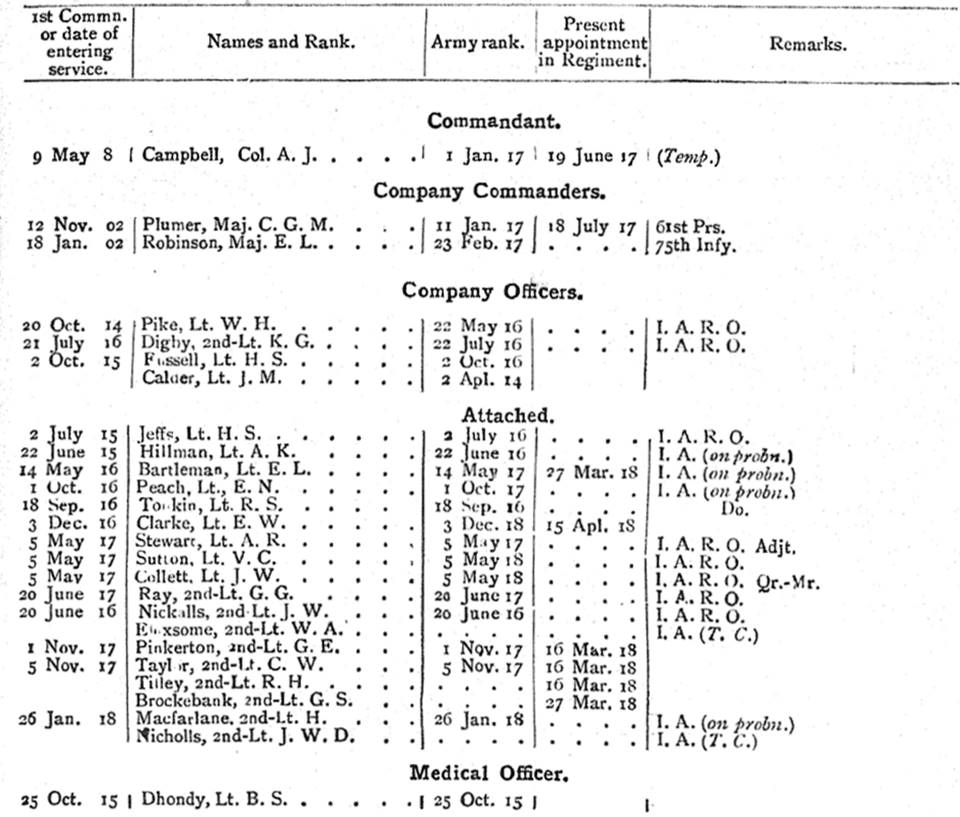This article on the short-lived 111th Mahars will give you an overview of the Regiment’s service during the First World War and help you research those who served with it. I have written a series of guides to help you research soldiers who served in the Indian Army during the war which you can read by clicking the link below:
The 111th Mahars in the First World War
Lineage: The 111th Mahars was formed at Mhow, India on 19 June 1917 and amalgamated with the 71st Punjabis early in 1922. On amalgamation, the Regiment was known as the 71-111th Infantry. At some point between July and November 1922, the Regiment was disbanded.
Class Composition of Battalion in 1919: 4 Companies of Mahars.
The 111th Mahars was a war raised regiment which was formed at Mhow on 19 June 1917. The Regiment consisted of four companies of Mahars, an untouchable caste, located in and around the present-day Indian state of Maharashtra. Mahars had been recruited during the 19th century but had fallen out of favour due to the martial raced theory and the Punjabisation of the Indian Army. During the First World War, recruitment difficulties meant that the Indian Army opened up enlistment to new groups. As the Mahars were considered an untouchable caste, other Indian soldiers would not serve with them, so they were formed into what was known as a class regiment. A class regiment was composed of soldiers from a specific group, or ‘race’.
The 111th Mahars did not see active service during the war and like other regiments raised from new classes was severely hampered by a lack of trained Indian officers and Non-commissioned officers. By January 1919, the unit was stationed at Jubbulpore where it was still stationed in August. The extract below was taken from the Regiment’s confidential report for 1918-1919 and was written by Brigadier-General Charles Gordon Prendergast, C.B. who commanded the Jubbulpore Brigade and was dated 19 February 1919:
Drill: Handling of arms good but more attention to details is required by young British Officers and also Indian Officers.
Manoeuvre: Men move quickly over rough ground but require further training.
Musketry: The results are good for range practices, but a large number have not been trained.
Fire Discipline: Satisfactory.
Signalling: Is in an elementary stage. None classified.
Bayonet Fighting: Requires attention. Bayonet fighting course has not yet been constructed.
Obstacle Course: A temporary course in camp has been made. More men should be practised.
Bombing: Is in an elementary stage. No live bombs have been thrown.
Lewis Gun: Drill satisfactory. Tactical handling requires more attention.
Marching Powers: Satisfactory.
Physical Appearance and Training: Physical standard is below the average of the Indian Army.
Packing and loading and entraining: Have been practised.
Arms: Complete, serviceable, properly browned, clean and regularly marked.
Equipment: Requires more attention. A great improvement has taken place recently.
Discipline: Satisfactory for the last 3 months since arrival in Jubbulpore.
I do not consider this battalion is fit for service; it is in a backward condition. This may be attributed to constant changes of station, viz., Mhow-Secunderabad-Santa Cruz-Baroda-Jubbulpore also to indifferent Indian Officers and lack of a good nucleus to train it.
Lieutenant-General Charles Alexander Anderson, made the following comment in the report which was dated 16 April 1919:
I agree with the Divisional Commander as regards the present time but possibly in future when time produces Mahars fit for the position of Non-Commissioned Officers and Indian Officers we shall find that better material will be forthcoming. I noticed very considerable improvement at my last inspection of the regiment, men had filled out owing to physical training and good rations and were much more soldierly in bearing than they were in the early days of the regiment. There is no doubt that the many changes of station militated severely against the training of this regiment. I fully expect to see much improvement even in the immediate future and still more so when we begin to have trained Mahars suitable for the position of Indian Officers and Non-Commissioned Officers.
Confidential review reports on Indian Army units, depots, British officers, etc. for 1918-1919: IOR/L/MIL/7/17030.
By February 1921, the Regiment had moved to Ahmednagar and by August was stationed at Aden, in present day Yemen. Aden was one of the worst postings in the British Empire and conditions during the summer were made horrendous by the heat. While stationed in Aden. the Regiment’s Depot was first at Anandi and later moved to Belgaum. By the end of the year, the Regiment’s Depot had been abolished and it was instead using the 21st Punjabis which had been converted to a training battalion. It had been decided during the year that the 111th Mahars and the 71st Punjabis were to be amalgamated and this took place early in 1922 at Aden. This newly amalgamated unit was known as the 71-111th Infantry and its Depot was at Mhow. At some point between July and November 1922, the Regiment which was still stationed at Aden was disbanded. It wasn’t until the outbreak of the Second World War, that Mahars were once again recruited into the Indian Army. The extract below was taken from the July 1918 Indian Army List which recorded the British officers serving with the Regiment.
War Diaries of the 111th Mahars
War diaries were written by an officer of a unit and recorded its location and activities. Unfortunately, there are no war diaries for the 111th Mahars.
Further Sources for the 111th Mahars
The 111th Mahars benefit from detailed regimental confidential reports which can be viewed at the British Library: Confidential Reports. These reports also contain the annual reports of the British officers serving with the Regiment. The Indian Army List will also contain information about the British and Indian officers serving with the unit.

